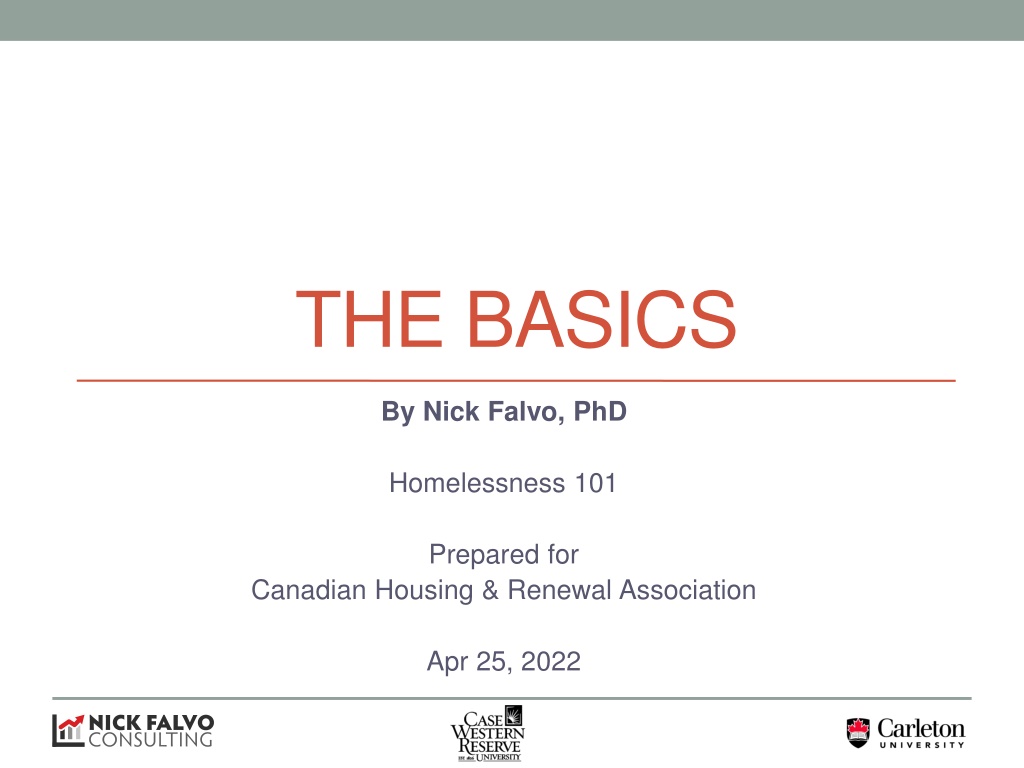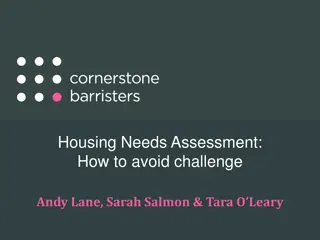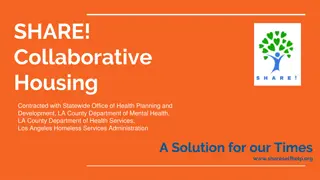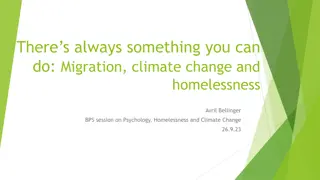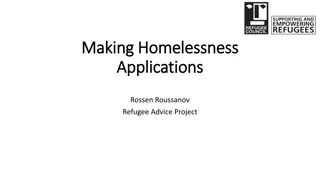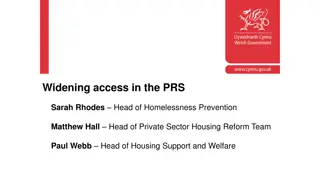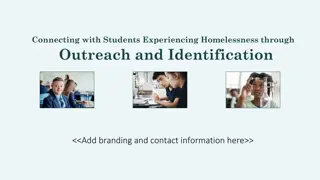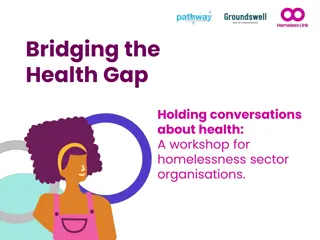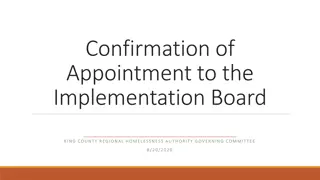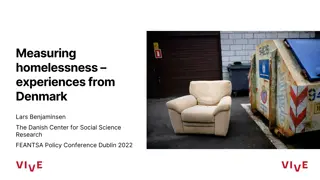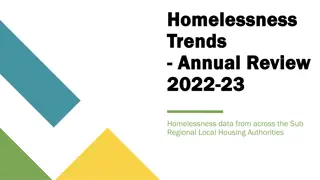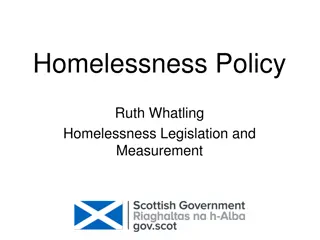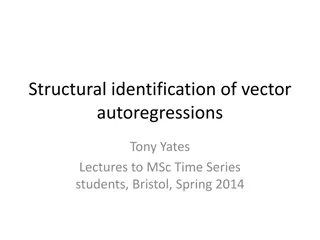Structural Causes of Homelessness
Structural causes of homelessness stem from a lack of alignment between housing costs and low-income households' ability to afford rent. Issues such as regulations hindering housing development, inadequate government interventions, and high poverty levels contribute to the problem. Different perspectives exist on the main factors driving homelessness, emphasizing the need for context-specific solutions.
Download Presentation

Please find below an Image/Link to download the presentation.
The content on the website is provided AS IS for your information and personal use only. It may not be sold, licensed, or shared on other websites without obtaining consent from the author.If you encounter any issues during the download, it is possible that the publisher has removed the file from their server.
You are allowed to download the files provided on this website for personal or commercial use, subject to the condition that they are used lawfully. All files are the property of their respective owners.
The content on the website is provided AS IS for your information and personal use only. It may not be sold, licensed, or shared on other websites without obtaining consent from the author.
E N D
Presentation Transcript
THE BASICS By Nick Falvo, PhD Homelessness 101 Prepared for Canadian Housing & Renewal Association Apr 25, 2022
Overview Causes Categorization Solutions
Structural causes What factors make the rate of per-capita homelessness higher in one community than in another? I m going to call such factors structural causes of homelessness.
Structural causes (contd) The most fundamental structural cause of homelessness is a lack of alignment between how much it costs to rent housing and how much low-income households can afford to pay for rent. The housing market simply doesn t cater well to low- income households.
Structural causes (contd) Why is this the case? The precise answer to this question depends on how one views the world. Here are some explanations offered by some practitioners, researchers and advocates:
Structural causes (contd) Rules and regulations make it too difficult for private developers to create rental housing. Govt does an inadequate job of regulating rent levels. Govt does an inadequate job of preserving what little low- cost rental housing already exists.
Structural causes (contd) Most govts don t invest enough in social housing. There s too much poverty. Income assistance programs, esp. social assistance, are inadequate.
Structural causes (contd) All of these points have a certain degree of merit. The extent to which each is responsible for a lack of affordable housing depends largely on context, Also, different ppl emphasize different factors (depending on how they view the world).
Structural causes (contd) CAVEAT Even in a community with very good availability of affordable housing, some homelessness is still inevitable.
Individual-level risk factors Whether a community has a little homelessness or a lot of homelessness, it can often be predicted which types of persons become homeless. The characteristics that increase the vulnerability of some persons to homelessness are known as individual-level risk factors.
Individual-level risk factors (contd) If officials can understand these, they can: a) Target prevention programs specifically at such individuals; and b) Design programs uniquely tailored to such individuals that can help them after they become homeless.
Individual-level risk factors (contd) The Nilsson et al. article provides odds ratios. The odds ratios refer to how many times more likely such a person is to experience homelessness than somebody without the characteristic in question (based on the cited study).
Individual-level risk factors (contd) Factors Odds ratio History in foster care 3.7 Having previously attempted suicide 3.6 History of running away 3.3 History of criminal behaviour 3.0 Physically abused as a child 2.9
Individual-level risk factors (contd) Persons with such risk factors should not be blamed for having them. For example, children do not choose to be in foster care; rather, they are there for reasons beyond their own control. And in many cases, a lack of housing affordability itself is a reason for some of these risk factors.
Systems failures Here I refer to publicly-funded systems working together in ways that are poorly-designed, poorly-implemented, or both. These systems failures have the unintended consequence of exacerbating homelessness.
Systems failures (contd) One example of a systems failure is a correctional facility discharging persons directly into homelessness without working proactively with local homelessness officials to create a soft landing.
Systems failures (contd) Another example pertains to youth aging out of care. While the child welfare system offered structure, suddenly the youth must fend for themselves on a low income. Housing secured by such youth is often shared (the youth might rent room in a house with complete strangers).
Systems failures (contd) They might struggle in their dealings with both housemates and a landlord. Perhaps not surprisingly, one recent study has found that youth who are permitted to stay longer in foster care are less likely to end up homeless.
Categorization of persons experiencing homelessness
Who is homeless? Where people are sleeping. Level of acuity or vulnerability according to an assessment tool. The ones that are going to require case management support their whole lives vs. the ones who won t.
Who is homeless (contd)? Household type/size (e.g., one-person household, families, etc.) Age of individuals (e.g., youth, older adults, etc.). Ethnicity (e.g., Indigenous).
Who is homeless (contd)? Traumatic experience (e.g., family violence, veterans, torture survivor). Status in Canada (e.g, refugee claimant).
Reaching Home Directives You are chronically homeless if you are currently experiencing homelessness and meet at least 1 of the following criteria: 1. You ve had a total of at least 180 days of homelessness over the past year. 2. You have recurrent experiences of homelessness over the past 3 years, with a cumulative duration of at least 18 months
Reaching Home Directives (contd) Definitions of absolute homelessness found in Reaching Home s Directives are based largely on definitions arrived at by the Canadian Observatory on Homelessness.
Cluster analysis Kuhn and Culhane (1998) did ground-breaking research in this area.
Cluster analysis (contd) They developed a typology of shelter stay patterns based on length of stay + rate of readmission. Their work focused on single homeless adults in New York City (1988 to 1995) & Philadelphia (1991 to 1995). They found three distinct patterns of stays, and termed them transitional, episodic, or chronic.
Cluster analysis (contd) Transitional shelter users = small # of episodes of homelessness over multi-year period. Episodic users = frequent episodes, cycling through shelter system, jail, hospital, treatment centres. Chronic shelter users = fewer, yet longer episodes of homelessness than episodic folks.
Solutions Limited resources result in a lot of debate. There s messiness in all of this. We all try to simplify. There s no recipe book.
Solutions (contd) Reasons why people become homeless differ, so solutions should too. It s not clear we have such a strong level of sophistication in our homeless-serving systems of care to have ready- made solutions to each type of homelessness. Fundamentally, everyone needs affordable housing.
Solutions (contd) There are unique pathways into homelessness, and unique pathways out. It s reasonable to suggest higher acuity and longer shelter stay mean more intensive supports. Key question: how many resources do you put into the various policy responses.
Solutions (contd) Some clients will always need social work support. Some will not. Some system-planning organizations are trying to do more with less. Experimentation e.g., Adaptive Case Management (to which we ll return on Oct 26).
Solutions (contd) Various levels of staff support Various models (e.g., scattered site vs. place-based) Various lengths of support (e.g., temporary, permanent) Non-housing options
Solutions (contd) Staff often learn a great deal about people after they ve been housed. Then, there can be course correction. That process is key. Ideally, your policy response should be flexible. It should be able to change with time, as you course correct.
Solutions (contd) The Calgary Homeless Foundation funds permanent place-based supportive housing (highest acuity) $35- $40K per person per year, and that does not include capital cost (i.e. up front costs on building). This cost also doesn t include social assistance.
Solutions (contd) By contrast, Adaptive Case Management (which we ll discuss later) would pay $5K per year for some people and get them housed (e.g., move-in costs, including damage deposit, some rent supp $).
Taking it all in We ve covered a lot of ground in this module. What s on your mind?
